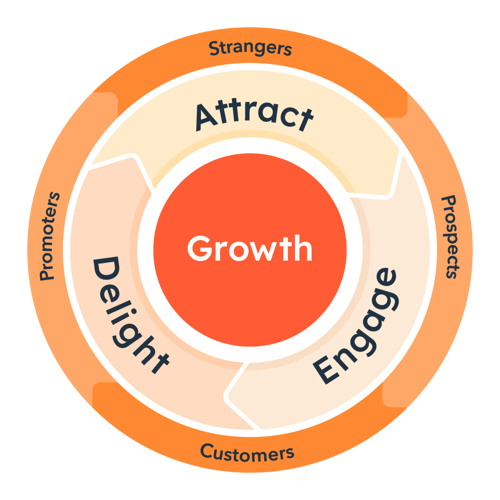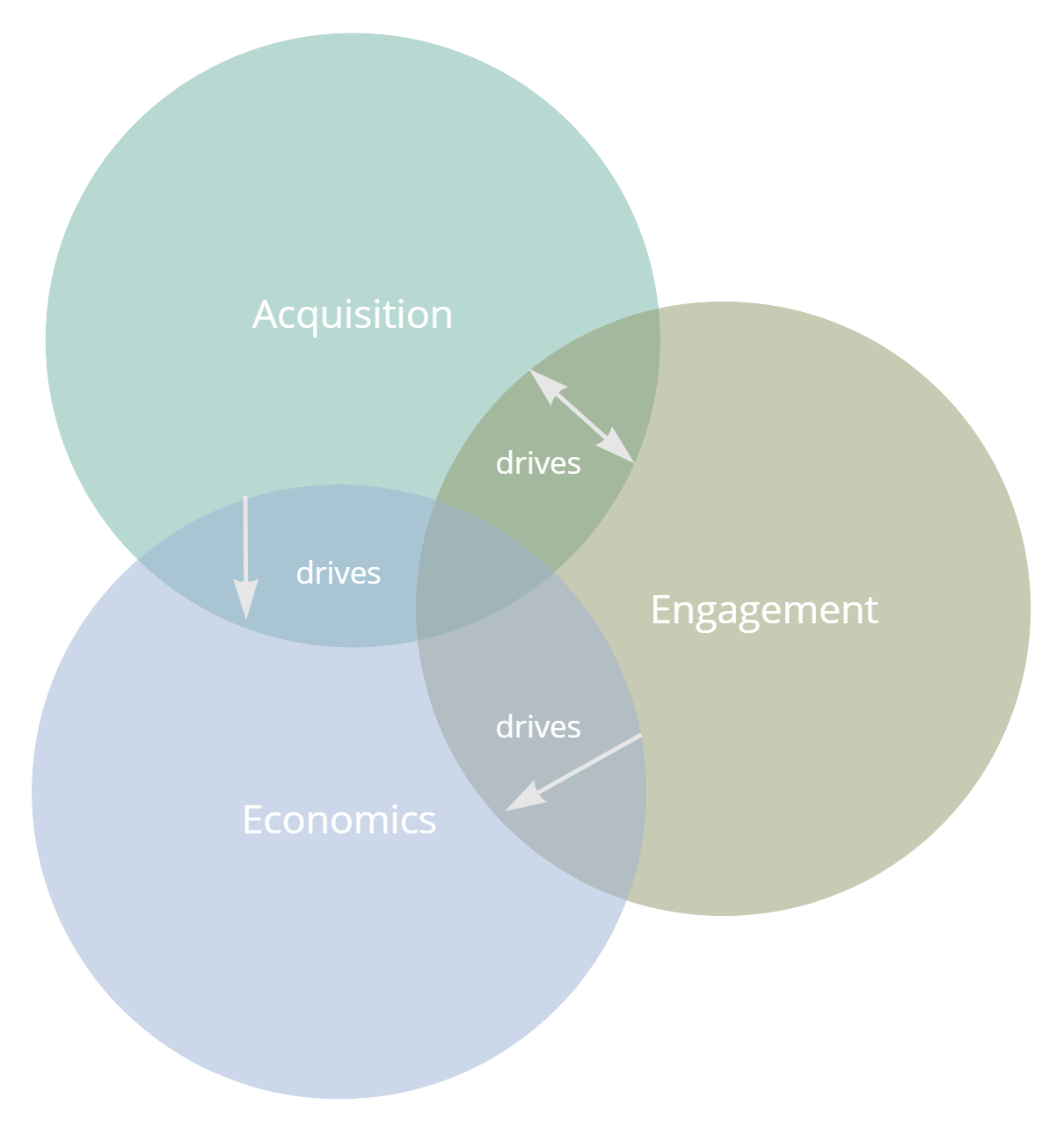Aspects of Growth - 3/3 Customers willing to pay significant money
How to thrive the success of your product centered business
Repetition
I tried to create a map one day of all aspects of a venture. I failed in the meaning of creating an overview but asked myself afterward what aspects really thrive growth and which are necessary evils. So the following is an idea of how to systematize aspects of growth.
There are three things you need for a successful business:
The right team
A killer product
Customers willing to pay significant money
and of course you need the investment to make the story big enough
As with writing the ideas and the content got more and more, Aspects of Growth will be released in three parts, one for each.
All things you do should be proven against those aspects. Things that don’t pay into one of them and aren’t prioritized against each other with that in mind, might be the wrong thing to do.
The second part was focusing on the product-aspect of Growth:
Network Effects
Network effects are describing an effect of exponential growth based on the connections between different parties focused on by your product. For airbnb this would be the combination of landlords and travelers. Examples also include social media platforms and marketplaces. To leverage network effects, focus on building a customer base and encourage interactions among their users. Features that promote user engagement and community-building can be instrumental. As described by Andrew Chen, the dynamic is best described as an very special interdependency between Acquisition, Engagement and Economics.
Aspects of Network Effects
Hard Side/Soft Side
There is always the hard side and the soft side, the party in the game that is hard to reach and convince and the party that is basically simply using and often making a buying (or using) decision based on the accomplishments you make on the hard side.
Network Effects are not easy to Establish
The network effect is not some magic that lets your growth rate accelerate just by talking about it. It is an effect that has to be seeded out and a plant that has to be sown and nurtured to grow big.
Cold Start Problem
The most challenging part is to get enough traction to overcome the cold start problem or if you like a space metaphor more:
You need enough acceleration to overcome the gravity of failure.
For more details there is the one book describing the network effect best by Andrew Chen: The Cold Start Problem
Deeper Insight
In B2B the network is often already there, like the business relations already established or the data streams happening, so you have to keep an eye on how to crack into those sub-networks, e.g. by attending the right events or optimizing your targeting based on those insights.
Hooking Users
Creating a habit-forming product involves designing it in a way that encourages repeated use. Nir Eyal's "Hooked" model – trigger, action, variable reward, and investment – is a useful framework for this. Implementing elements like notifications, rewards, and personal progress tracking can help in hooking users.
Read more on that topic in Nir Eyals book, also named Hooked.
Classical Sales
Sales strategies are fundamental to converting potential customers into actual buyers. This involves identifying target segments, understanding customer needs, and effectively communicating the value proposition.
Selling is not about the thing you do in the beginning, where you convince some early adopters to try out your product for no money in a pilot mode. It is about dirty work, getting customers in just with your value proposition and a lot of effort.
On that topic Amy Mitchell wrote a great article:
Deeper Insight
Building a skilled sales team that is able to navigate complex sales cycles and establish strong relationships with customers might seem outdated, talking about product based growth. For B2B scenarios it seems to be better to think of the customer experience and from there automate every part possible, but to keep an eye on the classic sales approaches. The customers are simply used to it and need to be convinced especially regarding the adoption of new products and technologies.
Personas and the ICP
In B2B sales, personas and Ideal Customer Profiles (ICPs) serve distinct but complementary roles. Personas are detailed representations of individual decision-makers or users within a target company, focusing on their motivations, pain points, and roles in the purchasing process. They help sales teams tailor messaging to specific stakeholders. On the other hand, an Ideal Customer Profile defines the characteristics of the ideal company or organization to target, such as industry, size, or revenue. ICPs help identify the right businesses to approach.
Deeper Insight
You have to know the people your selling to, but in B2B you especially have to know the profile of the company you’re selling to. It’s very important to differ between users and buyers in B2B product management while still integrating their experiences for a seamless customer journey.
Traditional personas, while useful in B2C, are less effective in the complex B2B landscape due to the varied motivations of buyers (focused on ROI) and users (focused on usability). I emphasize the need for both differentiation and blending of buyer and user experiences to create a holistic approach, advocating for systems thinking to manage these interdependent relationships.
For more:
The Marketing Flywheel
The Marketing Flywheel focuses on creating a momentum of customer engagement that drives growth. Unlike the traditional funnel, which ends at the sale, the flywheel continues to spin as you engage and delight customers. Tactics include content marketing, social media engagement, and customer advocacy programs.
The Marketing Flywheel was especially propagated by HubSpot co-founder Brian Halligan and fits well with the concepts of Hooking Users and Network effects as described in the last part.

Deeper Insight
Only if you are able to combine the efforts of product, marketing and sales there is a true chance for an effective growth model. Network Effects, Hooking Users and a marketing flywheel are great methods and concepts, but they only thrive if combined based on a common foundation.
Upselling
Upselling is about encouraging customers to purchase higher-end products or additional services or simply to use your product even more. Effective upselling requires understanding customer needs and preferences and offering relevant enhancements. Thinking of the marketing flywheel, you need to keep track of your customers business development. Upselling becomes part of your business model and your marketing approach as well. User retention is no longer just a topic of sales and user satisfaction, but of the product functionality itself.
Visibility via Branding and Public Relations
Visibility and transparency regarding the companies purpose builds trust and credibility with customers.
Branding including your identity, your tone of voice is the basis for marketing and PR activities! On the more subtle side it is about the mood, the associations and the recognizability of your company and product.
Public relations (PR) efforts should focus on clear and honest communication about the company's activities, values, and product developments. This can involve regular press releases, social media updates, and engaging content that showcases the company’s transparency and commitment to customer satisfaction. By proactively addressing issues and sharing successes, companies can build a positive public image. Transparency in business practices also involves being open about pricing, policies, and changes, which can foster a loyal customer base and differentiate the company from competitors.
Deeper Insight
Branding is not a discipline done by the marketing department through the mentioned measures. The core much more is about identity, transparency, culture, trust and authenticity!
Competition Analysis
Competition analysis is a critical component of any business strategy, providing insights into the strengths and weaknesses of rivals in your industry. By analyzing competitors, companies can identify gaps in the market, benchmark their own performance, and uncover opportunities for differentiation. This process involves evaluating competitors’ products, pricing strategies, marketing efforts, customer engagement, and market positioning. A thorough competition analysis not only informs decision-making but also ensures a proactive approach to staying ahead in the market, enabling businesses to adapt quickly to changes and maintain a competitive edge.
Deeper Insight
Do not only analyze your single competitors but the whole landscape of product categories around you. Defining your category helps you a lot to position yourself in an everchanging market! For that feel free to read:
Organizational Readiness for Service Operations
For your product to succeed, your organization must be ready to support it. This involves having the right processes, tools, and teams in place to manage customer inquiries, provide technical support, and handle operations efficiently.
For products that thrive by upselling and user retention the service gets part of the customer experience and thus of the product itself. So be aware to integrate everything.
Conclusion
In conclusion, focusing on these key aspects – team, product, and customer – can significantly drive the growth and success of your product-centered business. Each element plays a vital role, and balancing them effectively will help you achieve sustainable growth.













You hit all the important parts of growing your product in B2B! Thank you for the shout out 😎